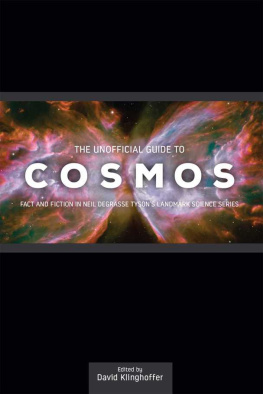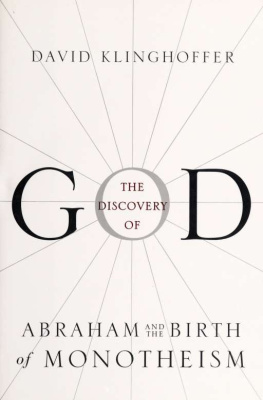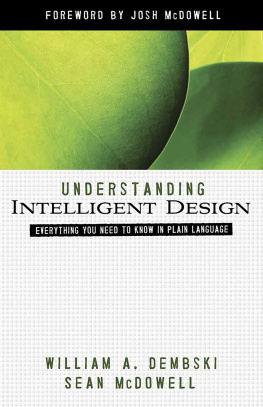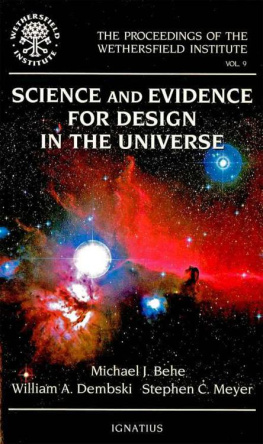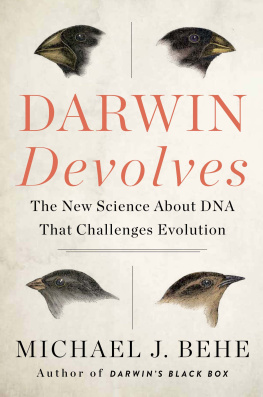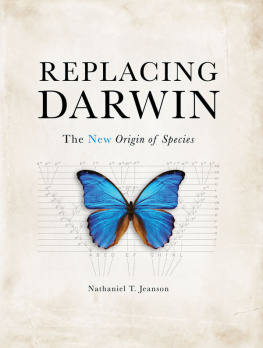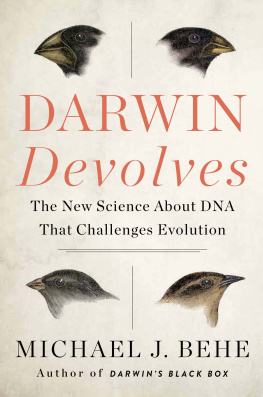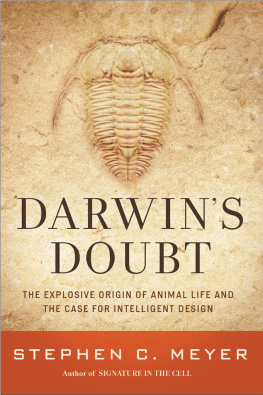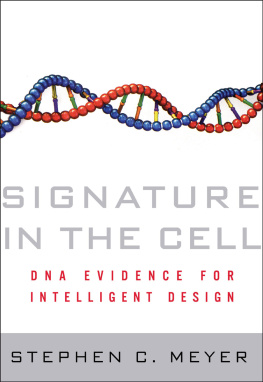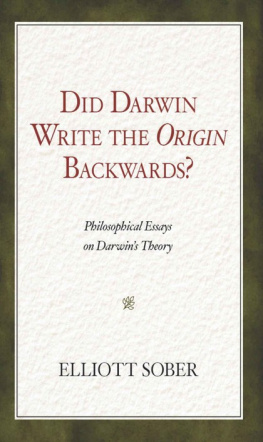Debating
Darwins
Doubt
A Scientific Controversy
that Can No Longer Be Denied
DAVID KLINGHOFFER, EDITOR
DISCOVERY INSTITUTE PRESS SEATTLE 2015
Description
This book contains essays responding to criticism of Darwins Doubt: The Explosive Origin of Animal Life and the Case for Intelligent Design by Stephen Meyer. The book explores topics such as orphan genes, cladistics, small shelly fossils, protein evolution, the length of the Cambrian explosion, the God-of-the-Gaps objection to intelligent design, and criticisms raised by proponents of theistic evolution. Contributors include Stephen Meyer, Douglas Axe, David Berlinski, William Dembski, Ann Gauger, Casey Luskin, and Paul Nelson. Edited by David Klinghoffer.
Copyright Notice
Copyright 2015 by Discovery Institute. All Rights Reserved.
Publishers Note
This book is part of a series published by the Center for Science & Culture at Discovery Institute in Seattle. Previous books include Signature of Controversy: Responses to Critics of Signature in the Cell, edited by David Klinghoffer; The Myth of Junk DNA by Jonathan Wells; The Deniable Darwin & Other Essays by David Berlinski; and Discovering Intelligent Design: A Journey into the Scientific Evidence by Gary Kemper, Hallie Kemper, and Casey Luskin.
Library Cataloging Data
Debating Darwins Doubt: A Scientific Controversy that Can No Longer Be Denied
Edited by David Klinghoffer.
BISAC Subject: SCI027000 SCIENCE / Life Sciences / Evolution
BISAC Subject: SCI080000 SCIENCE / Essays
BISAC Subject: SCI034000 SCIENCE / History
ISBN-13:
978-1-936599-30-1 (Kindle)
978-1-936599-31-8 (EPUB)
978-1-936599-28-8 (paperback)
Publisher Information
Discovery Institute Press, 208 Columbia Street, Seattle, WA 98101
Internet: http://www.discoveryinstitutepress.com/
First Edition. July 2015.
Contents
David Klinghoffer William Dembski David Klinghoffer Casey Luskin Stephen C. Meyer David Berlinski Casey Luskin David Berlinski David Berlinski & Tyler Hampton Casey Luskin Stephen C. Meyer Stephen C. Meyer Stephen C. Meyer Casey Luskin Stephen C. Meyer Douglas Axe Douglas Axe Ann Gauger Ann Gauger Douglas Axe David Klinghoffer David Klinghoffer Casey Luskin Casey Luskin David Klinghoffer David Klinghoffer Casey Luskin Evolution News & Views Casey Luskin Evolution News & Views Stephen C. Meyer Casey Luskin David Klinghoffer Paul Nelson Paul Nelson Casey Luskin David Klinghoffer Paul Nelson Casey Luskin Stephen C. Meyer Stephen C. Meyer Casey Luskin Stephen C. Meyer Stephen C. Meyer Casey Luskin
Introduction:
No Debate over
Darwinian Evolution?
David Klinghoffer
W hatever else Stephen Meyer demonstrated about the explosion of biological information required to build the Cambrian animals, his bestseller Darwins Doubt served as a massive rebuke to the mantra-like assertion that there is no debate, no controversy among scientists about Darwinian evolution.
Theres plenty! Meyer showed this in the book by addressing the arguments of prominent scientists who seek what they call a Third Way (neither intelligent design nor Darwinism) and a new theory of evolution. Nicely coinciding with the release of the paperback edition of Darwins Doubt , these researchers launched a provocative website, The Third Way , as a gathering place for those sharing their views. And Meyer showed it again with the new Epilogue, included in the paperback, in which he replied in detail to the most substantive of his critics.
Debating Darwins Doubt could be thought of as a supplement to what Dr. Meyer wrote in the Epilogue. The reception of Darwins Doubt , with serious scientific thinkers arguing back and forth about his thesis, was definitive evidence that the Darwinist mantra is wrong. If there is no scientific controversy about Darwinism versus intelligent design, how can one explain the volume of disputatious views aired in the wake of the books release?
Here we have gathered together a sample, collected mostly from writing by Discovery Institute scholars published at our popular news site Evolution News & Views . In these pages Stephen Meyer, Douglas Axe, Ann Gauger, William Dembksi, David Berlinski, Casey Luskin, Paul Nelson and I argue with critics including Charles Marshall (UC Berkeley), Robert Asher (Cambridge University), Martin Poenie (University of Texas), Donald Prothero (Natural History Museum of Los Angeles County), Nick Matzke (National Institute for Mathematical and Biological Synthesis), and others.
These critics arguments in turn were recycled by popular media outlets such as The New Yorker , National Review , First Things , and around the Internet including more than six hundred reviews (at the moment) on the books Amazon page. Nick Matzkes critiques at Pandas Thumb , in particular, became a guiding light for the recyclers, brandished again and again by both lofty and anonymous opponents of intelligent design. University of Chicago biologist Jerry Coyne, who writes the blog Why Evolution Is True and is arguably the American Richard Dawkins, pointed to Matzke as a justification for failing to wrestle with Meyers arguments himself. All this accounts for the extensive treatment given here to Matzke.
The critical response to Darwins Doubt was matched by warm appreciation from readersand from scientists in high places. Harvard University geneticist George Church praised it as an opportunity for bridge-building, rather than dismissive polarization. Biologist Scott Turner, State University of New York, saw in it an intriguing exploration of one of the most remarkable periods in the evolutionary history of life.
Russell Carlson, molecular biologist at the University of Georgia, said that it demonstrates, based on cutting-edge molecular biology, why explaining the origin of animals is now not just a problem of missing fossils, but an even greater engineering problem. Mark McMenamin, paleontologist at Mt. Holyoke College and co-author of The Emergence of Animals , greeted the book as a game changer for the study of evolution.
Bestselling novelist Dean Koontz even threw in an enviable accolade from his own professional perspective: Meyer writes beautifully. He marshals complex information as well as any writer Ive read.
Did I mention that Darwins Doubt hit #7 on the New York Times bestseller list, while also making the bestseller ranks at the Los Angeles Times and Publishers Weekly ? So obviously book-buyers were enthusiastic as well.
The challenge in editing this book was one of cutting and sifting from a vast literature in response to Darwins Doubt .
I was sad, for example, to have to exclude everything we wrote about University of Chicago pathologist Stephen Merediths essay in First Things . At a certain point, criticisms of the theory of intelligent design get so ridiculous and abstracted from reality that you throw up your hands in wonder. Yes, of course many unserious thinkers too have joined the mob arrayed against Meyers book.
It was disappointing not to include Martin Poenies contribution to ENV in the series where he disputed with Biologic Institutes Douglas Axe about the thesis of Darwins Doubt . When I contacted him as a courtesy to ask permission to republish his article, Dr. Poenie first answered that he couldnt remember writing one. When I sent him the link, repeatedly, he then chose not to respond at all. Whether this means Poenie lost confidence in his arguments after having them refuted by Dr. Axe, I cannot tell.
I also would have wanted to include something about theistic evolutionist Karl Gibersons public debate with Stephen Meyer, in which Meyer talked about the evidence for design in the Cambrian explosion. Dr. Giberson, a physicist and theistic evolutionist, displayed a photo of a baby with what appeared to be a perfectly formed tail to strengthen his case for our common descent from a tailed ancestor. Later, writing at The Daily Beast and once again using the photo, he mused about why Meyer could not refute the argument represented by the image. As we reported at ENV , however, the supposed evolutionary vestige turned out to be nothing more than a Photoshopped fake,
Next page

